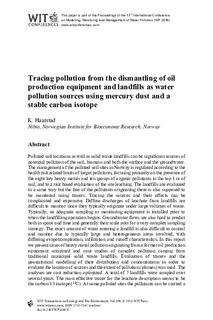| dc.contributor.author | Haarstad, Ketil | |
| dc.date.accessioned | 2018-05-31T07:50:04Z | |
| dc.date.available | 2018-05-31T07:50:04Z | |
| dc.date.created | 2017-02-07T14:17:02Z | |
| dc.date.issued | 2016 | |
| dc.identifier.citation | Haarstad, K. (2016). Tracing pollution from the dismantling of oil production equipment and landfills as water pollution sources using mercury dust and a stable carbon isotope. WIT Transactions on Ecology and the Environment, 209, 27-34. | nb_NO |
| dc.identifier.issn | 1743-3541 | |
| dc.identifier.uri | http://hdl.handle.net/11250/2499851 | |
| dc.description.abstract | Polluted soil locations as well as solid waste landfills can be significant sources of potential pollution of the soil, biomass and both the surface and the groundwater. The management of the polluted soil sites in Norway is regulated according to the health risk related limits of target pollutants, focusing primarily on the presence of the eight key heavy metals and ten groups of organic pollutants in the top 1 m of soil, and to a risk based evaluation of the site leaching. The landfills are evaluated in a same way but the fate of the pollutants originating there is also supposed to be monitored using tracers. Tracing the sources and their effects can be complicated and expensive. Diffuse discharges of leachate from landfills are difficult to monitor since they typically originate under large volumes of waste. Typically, no adequate sampling or monitoring equipment is installed prior to when the landfilling operation begins. Groundwater flows are also hard to predict both in space and time and generally their scale asks for a very complex sampling strategy. The exact amount of water entering a landfill is also difficult to control and monitor due to typically large and heterogeneous areas involved, with differing evapotranspiration, infiltration and runoff characteristics. In this report we present cases of heavy metal pollution originating from a former oil production equipment scrapyard and case studies of complex pollution coming from traditional municipal solid waste landfills. Evaluation of tracers and the geostatistical modelling of their distribution and concentrations in order to evaluate the location of sources and the extent of pollution (plumes) was used. The analyses are cost reduction optimized. A total of 7 landfills were sampled over several years. The most effective tracer for the leachate description seems to be the carbon-13 isotope (13C). At some polluted sites the pollutants can be carried a great length due to wind erosion. Geostatistical methods and the software Grapher were applied. It became obvious that the public health focused risk assessments become difficult when the inflicted areas are large. | nb_NO |
| dc.language.iso | eng | nb_NO |
| dc.subject | Tungmetaller | nb_NO |
| dc.subject | Heavy metals | nb_NO |
| dc.subject | Geostatistikk | nb_NO |
| dc.subject | Geostatistics | nb_NO |
| dc.subject | Sigevann | nb_NO |
| dc.subject | Leachate | nb_NO |
| dc.title | Tracing pollution from the dismantling of oil production equipment and landfills as water pollution sources using mercury dust and a stable carbon isotope | nb_NO |
| dc.type | Journal article | nb_NO |
| dc.type | Peer reviewed | nb_NO |
| dc.description.version | publishedVersion | nb_NO |
| dc.subject.nsi | VDP::Naturressursforvaltning: 914 | nb_NO |
| dc.subject.nsi | VDP::Natural resource management: 914 | nb_NO |
| dc.source.pagenumber | 27-34 | nb_NO |
| dc.source.volume | 209 | nb_NO |
| dc.source.journal | Wit Transactions on Ecology and The Environment | nb_NO |
| dc.identifier.doi | 10.2495/WP160031 | |
| dc.identifier.cristin | 1447931 | |
| cristin.ispublished | true | |
| cristin.fulltext | original | |
| cristin.qualitycode | 1 | |
